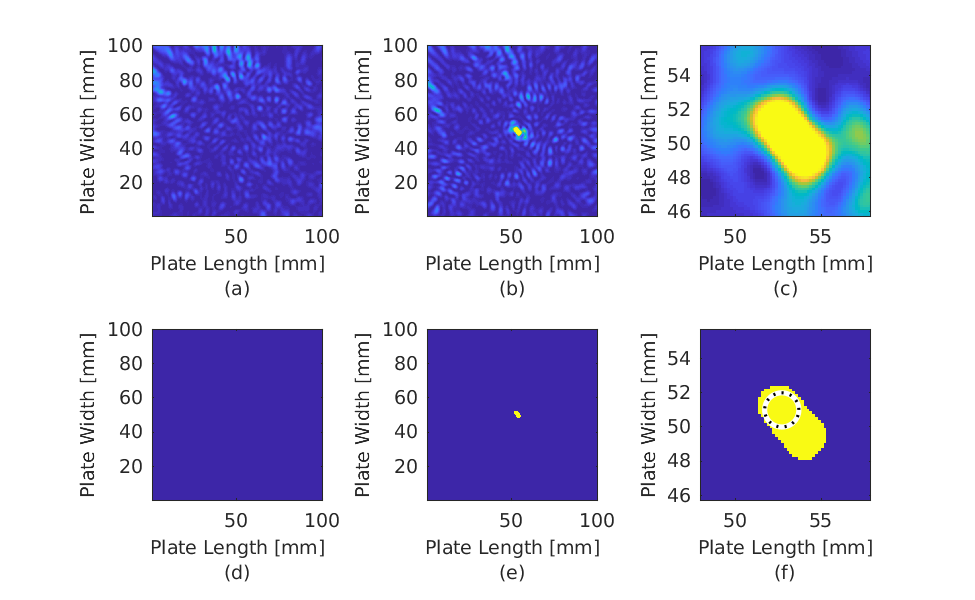Statistical Partial Wavefield Imaging Repository

Summary
Statistical Partial Wavefield Imaging (SPWI) is a powerful signal processing algorithm designed to detect and localize structural damage using sparse ultrasonic sensor arrays. Unlike traditional imaging methods that require dense sensor grids or full wavefield measurements, SPWI extracts high-quality damage localization images from partial and limited measurements, making it ideal for real-world Structural Health Monitoring (SHM) applications.
This CodeOcean capsule contains a complete implementation of the SPWI algorithm as introduced in:
Harley, J. B., & Chia, C. C. (2017). Statistical partial wavefield imaging using Lamb wave signals. Structural Health Monitoring, 17(4), 932–944.
🧩 The Problem: Sparse Data, Incomplete Fields
Lamb waves are widely used in SHM due to their ability to travel long distances and interact sensitively with damage. But generating high-resolution images of damage typically requires:
- Dense wavefield measurements,
- Full baseline datasets, and
- Detailed physical modeling.
In many practical cases (e.g., aircraft, bridges, pipelines), this level of sensing is impractical or impossible.
🧠 The Solution: Statistical Inference from Partial Fields
SPWI solves this by using partial wavefield data—a small subset of wave measurements—combined with a statistical model that estimates how signals should behave across the structure. It then builds an image that statistically highlights anomalous behavior—which may correspond to damage.
Core Idea:
Let ![]() be a measured wavefield at position xxx and time ttt, and suppose we have access to only a limited number of these measurements.
be a measured wavefield at position xxx and time ttt, and suppose we have access to only a limited number of these measurements.
The algorithm computes a statistical similarity metric between each region’s measured signal and an expected “healthy” response using:
![]()
Then, it projects this error across a spatial grid, forming a statistical image of potential damage regions.
🧪 What Makes SPWI Unique?
- 📉 Works with sparse data: Effective even with fewer than 10% of full-field measurements.
- 🧠 Model-free: Doesn’t require a physics-based model of wave propagation.
- 🔍 Highlights anomalies statistically—rather than just visually or heuristically.
- 🔄 Compatible with many wave types: Primarily Lamb waves, but generalizable.
📦 What’s Inside This Capsule?
- ✅ MATLAB code implementing the full SPWI algorithm
- 📂 Sample Lamb wave data (experimental or simulated)
- 📊 Image generation scripts for damage visualization
- 📘 Documentation to guide users through input/output
🛠️ Why Use SPWI?
- 🚀 Practical: Works with real-world limitations on sensors and data
- 🧠 Statistically robust: Based on quantitative comparison, not qualitative interpretation
- 🧱 Modular: Can be integrated with existing SHM systems or extended with machine learning
- 🌍 Field-proven: Validated in both lab and realistic environments
📚 Reference
Harley, J. B., & Chia, C. C. (2017). Statistical partial wavefield imaging using Lamb wave signals. Structural Health Monitoring, 17(4), 932–944.
🔗 https://doi.org/10.1177/1475921717735329
This capsule provides a ready-to-use toolkit for turning limited Lamb wave data into powerful damage images. Whether you’re working with embedded sensors in composite wings or field inspections on civil infrastructure, SPWI helps you see more with less.
Let data scarcity be an opportunity—not a limitation.
Lamb Wave Linear Algebra Nondestructive Testing Physical Mismatch Sparse Wavenumber Analysis Structural Health Monitoring Undersampling

